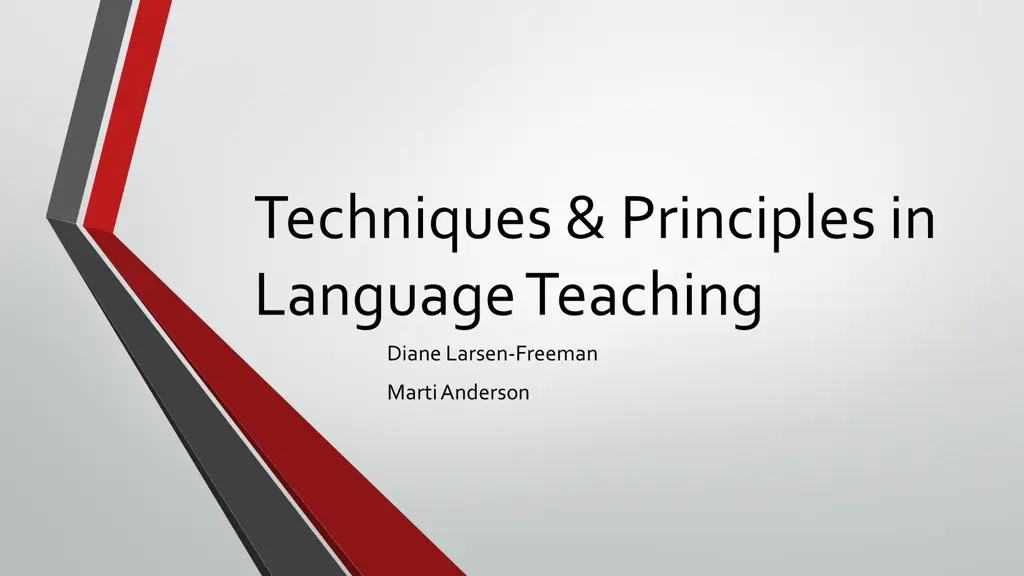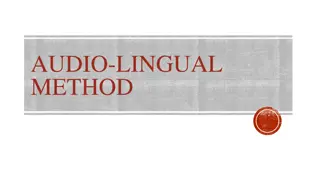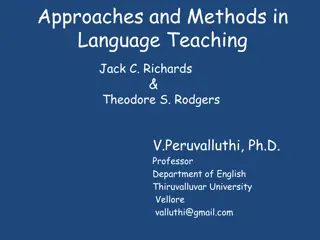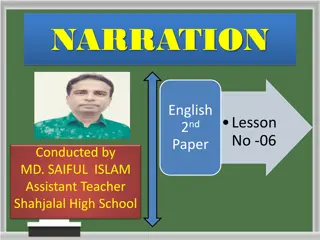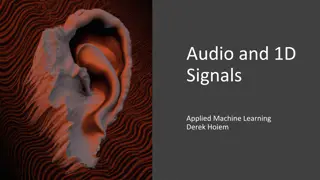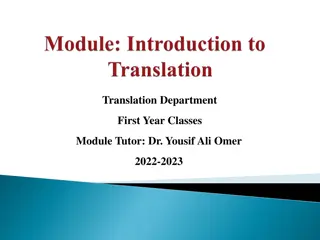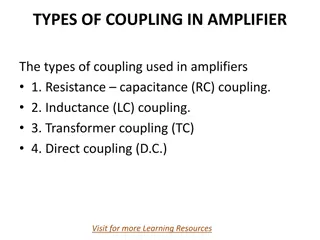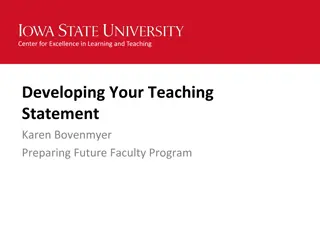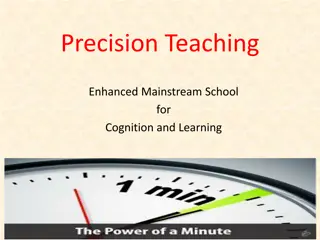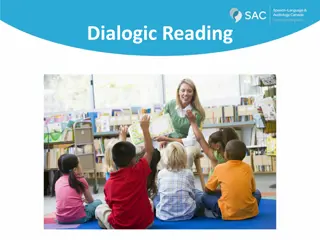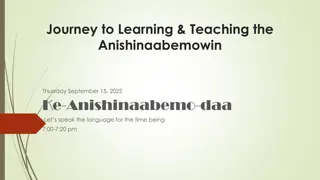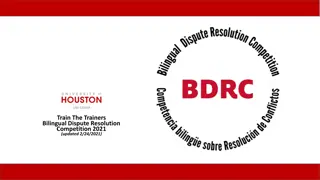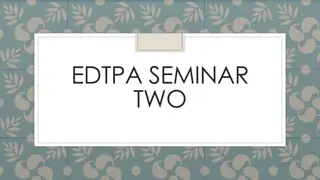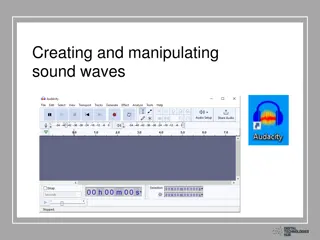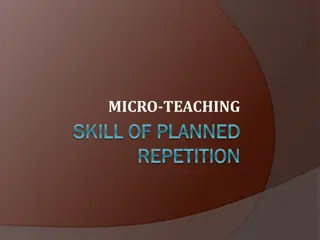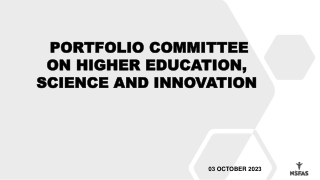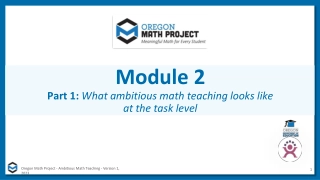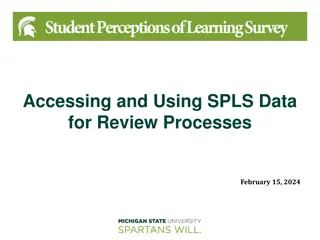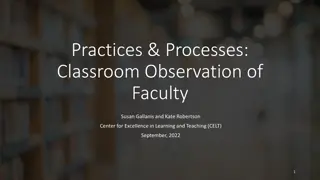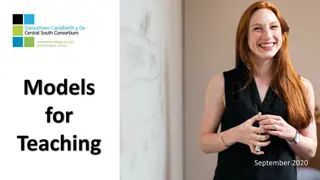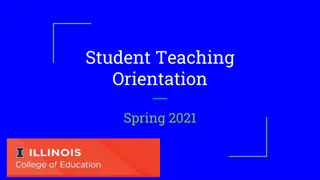Language Teaching Techniques: GTM, Direct Method & Audio-Lingual Method
Explore the Grammar-Translation Method, Direct Method, and Audio-Lingual Method in language teaching. Understand principles, objectives, and methodologies with insights into language learning approaches. Enhance teaching skills and foster effective communication in language education.
Download Presentation

Please find below an Image/Link to download the presentation.
The content on the website is provided AS IS for your information and personal use only. It may not be sold, licensed, or shared on other websites without obtaining consent from the author. Download presentation by click this link. If you encounter any issues during the download, it is possible that the publisher has removed the file from their server.
E N D
Presentation Transcript
Techniques & Principles in Language Teaching Diane Larsen-Freeman Marti Anderson
The Grammar-Translation Method (GTM)
Schools of Thought Structuralism/ Behaviorism Generativism/ cognitivism Constructivism Grammar- Translation Method Audio-Lingual Method Silent Way Communicative Language Teaching Desuggestopedia Methods Direct Method Community Language Learning Content-based Instruction Total Physical Response Task-based Language Teaching
Principles of GTM GTM or Classical Method Used in late 19thcentury Theoryless Fundamental purpose of learning a lg. : to read literature of that lg. and intellectual development An important goal: to translate Communication is not a goal Primary skills: reading & writing Teacher is the authority Students to learn about grammar of the lg. Attention to similarities bet. NL & TL: Cognates Grammar taught deductively Memorization Lg. learning = mental exercise
Principles of The Direct Method DM, as a reaction to GTM Weak theoretical foundations Basic rule: NO TRANSLATION IS ALLAOWED (no native lg.) Meaning conveyed directly thru demonstration & visual aids (realiaor pictures) Lg. is primarily speech Vocabulary acquired naturally in sentences rather than memorized as a list Purpose of lg. learning: communication (lg. to be used in real context thru speaking) Pronunciation is important Grammar taught inductively Syllabus is based on situations and topics, not on linguistic structures
Principles of Audio-Lingual Method Like DM is an oral-based approach. Drills students in the use of grammatical sentence patterns. Has a strong theoretical base in linguistics & psychology (structuralism/behaviorism) Sentence patterns are acquired thru conditioning; i.e. helping students respond correctly to stimuli thru positive reinforcement learners overcome habits of NL and form new habits required for speaking TL
Lg. forms occur most naturally within a context. NL & TL have separate linguistic systems. They should be kept apart to avoid interference. Teacher s role: an accurate model (orchestra leader); students should mimic the model. Lg. learning is a process of habit formation; the stronger the habit, the greater the learning
It is impo.to prevent learners from making errors. Errors lead to formation of bad habits. Errors should be corrected immediately. Purpose of lg.: to learn how to use lg. to communicate Students should overlearn : learn to answer automatically without stopping to think. Major objective of lg. teaching: for students to acquire the structural patterns
Learning of another lg. should be the same as the acquisition of the NL (inductive learning). Major challenge of teaching: getting students to overcome the habits of their NL Speaking is more basic to lg. than the written form (natural order). Lg. cannot be separated from culture.
One problem with ALM: students inability to transfer classroom habits to communication use outside it. The idea of lg. learning as habit formation was challenged by Chomsky (speakers have a knowledge of underlying abstract rules, which allow them to understand and create novel utterances) Lg. is rule formation rather than habit formation. Lg. acquisition must be a procedure whereby people use their own thinking processes, or cognition, to discover the rules of the lg. they are acquiring.
Emphasis on human cognition led to the establishment of the Cognitive Code Approach. Learners are responsible for their own learning (learner autonomy). Errors are inevitable and are signs that learners were actively testing their hypotheses to discover rules of TL. No lg. teaching method ever really developed directly from Cognitive Code Approach Instead, a number of innovative methods emerged.
Innovative Methods 1. The Silent Way 2. Desuggestopedia 3. Community Language Learning 4. Total Physical Response
The Silent Way Basic principle: teaching should be subordinated to learning. Learning is a process we initiate by ourselves by mobilizing our inner resources ( our perception, awareness, cognition, imagination, intuition, creativity). Teachers should start from sth the students already know (e.g. sounds)
Teacher should give only what help is necessary. Students are responsible for their own learning; they develop their own inner criteria for correctness. Silence is a tool to help foster autonomy; teacher speaks only when necessary. Meaning is made clear by focusing students perceptions, not thru translation.
Teachers silence encourages group cooperation. Teacher avoids praises or criticizes to make students more self-reliant. Self-correction of errors A great deal of meaningful practice without repetition Lg. is for self-expression The syllabus is composed of linguistic structures which are constantly being recycled, not arranged in a linear fashion.
Desuggestopedia The reason for our inefficiency is psychological barriers to learning. We only use 5-10% of our mental capacity To make better use of our reserve capacity, our limitations need to be desuggested. One way to stimulate mental reserves: the integration of fine arts
Principles Learning is facilitated in a cheerful environment. Peripheral learning: a student can learn from what is present in the environment, even if his attention is not directed to it. The teacher should desuggest psychological barriers. The teacher should integrate indirect positive suggestions into the learning situations. e.g. : there is no limit to what you can do
The teacher should present and explain the grammar and vocabulary but not dwell on them. Fine art provides positive suggestions for students. One way that meaning is made clear is thru native language translation.
Communication takes place on two planes: 1. conscious plane: learners attend to the lg. (linguistic message is encoded). 2. subconscious plane: the music suggests that learning is easy and pleasant.
Teacher should avoid repetition in class activities as much as possible. Novelty aids acquisition. It is desirable that students achieve a state of infantilization so that they will be more open to learning. Errors are corrected gently, not in a direct, confrontational manner.
Community Language Learning (CLL) Whole-person learning: teachers consider not only their students intellect, but they also have some understanding of -the relationship among students feelings, -physical reaction, -instinctive protective reactions, -desire to learn
CLL takes its principles from Counseling Learning approach developed by Charles A. Curran Curran found that adults often feel threatened by a new learning situation. One way to deal with students fear: teachers to become language counselors; i.e. someone who is a skillful understander of the struggle students face.
Principles Building a relationship with and among students is very important. Language is for communication. Teacher does not stand in front the class to -reduce the threat & facilitate learning -to foster interaction among students, rather than only from student to teacher
Sharing learners feelings about their learning experience allows them to get to know one another and to build community. Teacher creates an accepting atmosphere guided by the knowledge that each learner is unique. Teacher counsels students; i.e. he doesn t offer advice, but rather shows them that he is really listening to them and understands what they are saying.
Native lg. is used to make meaning clear; students feel secure when they understand everything. Non-defensive learning: SAARRD Security Attention Aggression Reflection Retention Discrimination
Cooperation, not competition is encouraged. Developing a community builds trust & reduces the threat of the new learning situation. Retention will best take place somewhere in between novelty & familiarity (not too new, not too familiar).
Reflection on -language & -what was experienced in community learning In the beginning stages, the syllabus is generated primarily by the students. Students are more willing to learn when they have created the material themselves.
Total Physical Response Chapter 8
Introduction Comprehension Approach: a general app. to FL instruction which gives importance to listening comprehension. Language learning starts first with understanding & ends with production. This is exactly how infants acquire its native language.
Methods fitting within the Comprehension Approach: 1. Natural approach (Krashen & Terrel) -emphasis on basic communication skills (like DM) -comprehensible input (i + 1): meaningful exposure to TL -meaning is given priority over form (voc. acquisisionis stressed) -acquisition is favored over learning -low affective filter 2. Self-instructional program (Winitz & Reeds) & The Learnables(Winitz) -listening to tape-recorded words, phrases, & sentences while looking at pictures 3. Lexical Approach (Lewis) -less concerned with production and more concerned with comprehension -centrality of lexicon & multiword lexical items (chunks), not grammar, functions, etc. 4. Total Physical Response (Asher) 5. -the fastest, least stressful way to achieve understanding is to follow the directions
Principles Meaning can often be conveyed thru actions. Beginning lg. instruction should address the right hemisphere of the brain which controls nonverbal behavior. The TL should be presented in chunks, not just word by word.
Understanding should be developed before speaking. The imperative is a powerful linguistic device thru which the teacher can direct student behavior. Feeling of success & low anxiety facilitate learning.
Correction should be done in an unobtrusive manner (not easily noticed). Novelty is motivating (teacher gives students commands they ve not heard before). Lg. learning is more effective when it is fun.
Spoken lg. is emphasized over written lg. Students will begin to speak when they are ready. Errors are expected & should be tolerated (working on the fine details of the lg. should be postponed until students have become proficient).
Communicative Language Teaching Chapter 9
Introduction Shift from linguistic structure-centered approach to a Communicative Approachin the late 1970s and early 1980s. Language is fundamentally social. Being able to communicate requires more than mastering linguistic structure (linguistic competence). Communication requires communicative competence knowing when and how saying what to whom (Hymes, 1971_.
Communicative Competence Language Socialization in SLA: -of paramount importance in LA -it "stands to contribute the most to an understanding of the cognitive, cultural, social, and political complexity of language learning" Social constructivist perspectives: -central focus -language as interactive communication among individuals, each with a sociocultural identity
DEFINLNG COMMUNICATIVE COMPETENCE (CC) Coined by Dell Hymes (1972,1967), a sociolinguist Hymesbelieved that Chomsky's (1965) notion of competence was too limited. Chomsky's "rule-governed creativity" did not account sufficiently for the social and functional rules of language.
Hymes referred to CC as that aspect of our competence that enables us to convey and interpret messages and to negotiate meanings interpersonally within specific contexts. Savignon noted that "communicative competence is relative, not absolute, and depends on the cooperation of all the participants involved." It is not so much an intrapersonal construct as we saw in Chomsky's early writings but rather a dynamic, interpersonal construct
linguisticcompetence vs. communicativecompetence knowledge "about" language forms knowledge that enables a person to communicate functionally and interactively
James Cummins (1980, 1979) introduced CALPvs. BICS CALP :cognitive/academic language proficiency (linguistic) BICS: basic interpersonal communicative skills (communicative) CALP is that dimension of proficiency in which the learner manipulates or reflects upon the surface features of language outside of the immediate interpersonal context. It is what learners often use in classroom exercises and tests that focus on form. BICS is the communicative capacity that all children acquire in order to be able to function in daily interpersonal exchanges.
Cummins later (1981) modified his notion of CALP and BICS (dimension of context is added): Context-reduced communication CALP BICS Classroom & school language face-to-face communication vs. Context-embedded communication
Swain's and later in Canale's (1983) definition, four different components, or subcategories, made up the construct of CC. The first two subcategories reflected the use of the linguistic system itself; the last two defined the functional aspects of communication 1.Grammatical competence 2.Discourse competence 3.Sociolinguistic competence 4.Strategic competence
Strategic Competence: occupies a special place Compensatory strategies Swain (1984, p, 189) amended the earlier notion of strategic competence to include "communication strategies that may be called into action either to enhance the effectiveness of communication or to compensate for breakdowns." Yule and Tarone(1990, p. 181) referred to strategic competence as "an ability to select an effective means of performing a communicative act that enables the listener/reader to identify the intended referent. In fact, strategic competence is the way we manipulate language in order to meet communicative goals
Here, strategic competence almost serves an "executive" function of making the final "decision," among many possible options, on wording, phrasing, and other productive and receptive means for negotiating meaning.
LANGUAGE FUNCTIONS Functions are essentially the purposes that we accomplish with language, e.g., stating, requesting, responding, greeting, parting, etc. Functions cannot be accomplished, of course, without the forms of language: morphemes, words, grammar rules, discourse rules, and other organizational competencies. While forms are the outward manifestation of language, functions are the realization of those forms.
Communication is not merely an event, something that happens; it is functional, purposive, and designed to bring about some effect some change, however subtle or unobservable on the environment of hearers and speakers. Communication is a series of communicative acts or speech acts, to use John Austin's (1962) term, which are used systematically to accomplish particular purposes. Austin stressed the importance of consequences, the perlocutionaryforce, of linguistic communication.
Principles Authentic lg. lg as it is used in a real context should be introduced. Understanding the speaker s or writer s intentionsis part of being communicatively competent. TL is a vehicle for classroom communication, not just the object of study.
